China is so vast that it has a plethora of ecosystems. From mountains to rivers and rainforests, with so many unique environments there’s no wonder China has so many interesting endemic animals. While some animals, like the giant and red pandas are well-known around the world, China has a myriad of animals that you may never have heard of.
Due to rapid urban development in China, many of the species on this list of 20 endemic animals in China are endangered or being closely monitored. China faces an uphill battle, much like the rest of the world when it comes to wildlife conservation. If the same improvements are made, that have been achieved with giant pandas, then maybe there will be more chances of people seeing these endemic animals in their natural habitats.
Contents
- 20 Endemic Animals of China
- Top Tours
- 1- Giant Panda
- 2- Red Panda
- 3- Chinese Alligator
- 4- Golden Snub-Nosed Monkey
- 5- South China Tiger
- 6- Chinese Mountain Cat
- 7- Crested Ibis
- 8- Père David’s Deer
- 9- Golden pheasant
- 10- Qinling Panda
- 11- Hainan Black-crested Gibbon
- 12- Golden Takin
- 13- Tufted Deer
- 14- Asiatic Black Bear
- 15- Chinese Giant Salamander
- 16- Asian Elephant
- 17- Clouded leopard
- 18- Sable
- 19- North Chinese Leopard
- 20- Tibetan Macaque
20 Endemic Animals of China
Top Tours
- Private 5-Day Amazing Trip: Chengdu and Jiuzhaigou – see Giant Pandas on this trip.
- Private 4-Night Zhangjiajie Photography Trip – see the stunning landscapes of the mountains featured in “Avatar”.
- Chengdu: 3-Day Jiuzhai – Huanglong Bullet Train Private Tour.
1- Giant Panda
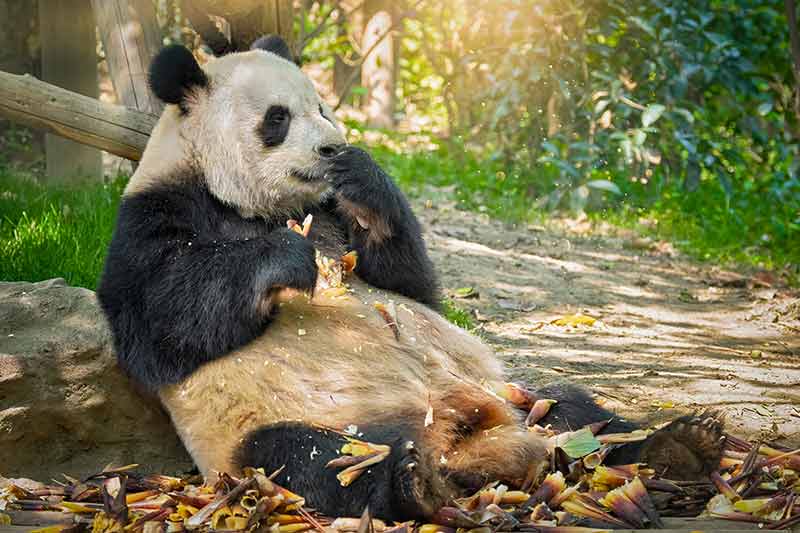
Giant pandas are the most iconic of China’s endemic animals.
They are effortlessly adorable and an important part of China’s identity on a world stage.
Giant pandas are unique and although they are bears, they don’t behave in the same way as many other bears.
For example, they do not hibernate in winter, they simply migrate to warmer areas.
Everyone knows that panda’s eat bamboo, but did you know that it accounts for 99% of their diet.
They are omnivores though, so they will eat fish, eggs, worms and insects.
The only natural habitat where you can see giant panda’s is southwest China.
They are one of the rarest species in the world, but China and wildlife organisations are making strides to help the species.
The panda is the WWF’s logo after all!
Today there are fewer than 1,850 pandas left in the wild.
Pandas primarily come from the Yangtze Basin region of China.
The Yangtze basin has seen massive infrastructural development over the past decades which has severely impacted the panda population.
The loss of forest and access to bamboo is what has caused the giant panda population to decline so rapidly.
But it’s not all doom and gloom for this magnificent creature.
For some time, pandas have been classified as “endangered” by the International Union for Conservation of Nature (IUCN).
However, recently pandas have been downgraded to “vulnerable” because of a 17% increase in population in the last decade.
This is positive news as government regulations and conservation efforts seem to be working.
If you are heading to China and want to see these fluffy animals, the best place to go is Chengdu in Sichuan province.
The chance of seeing a panda in the wild is rare and it’s also extremely difficult to access the area.
The best alternative is to head to the Chengdu Research Base of Giant Panda Breeding. You can buy a ticket to visit or join a tour.
It does feel a little like a zoo, but the enclosures are much bigger, and they work more towards the development and population protection of the animals.
There are 120 giant pandas at the centre and be sure to visit in the morning (before 8 am) because the pandas are most active.
2- Red Panda
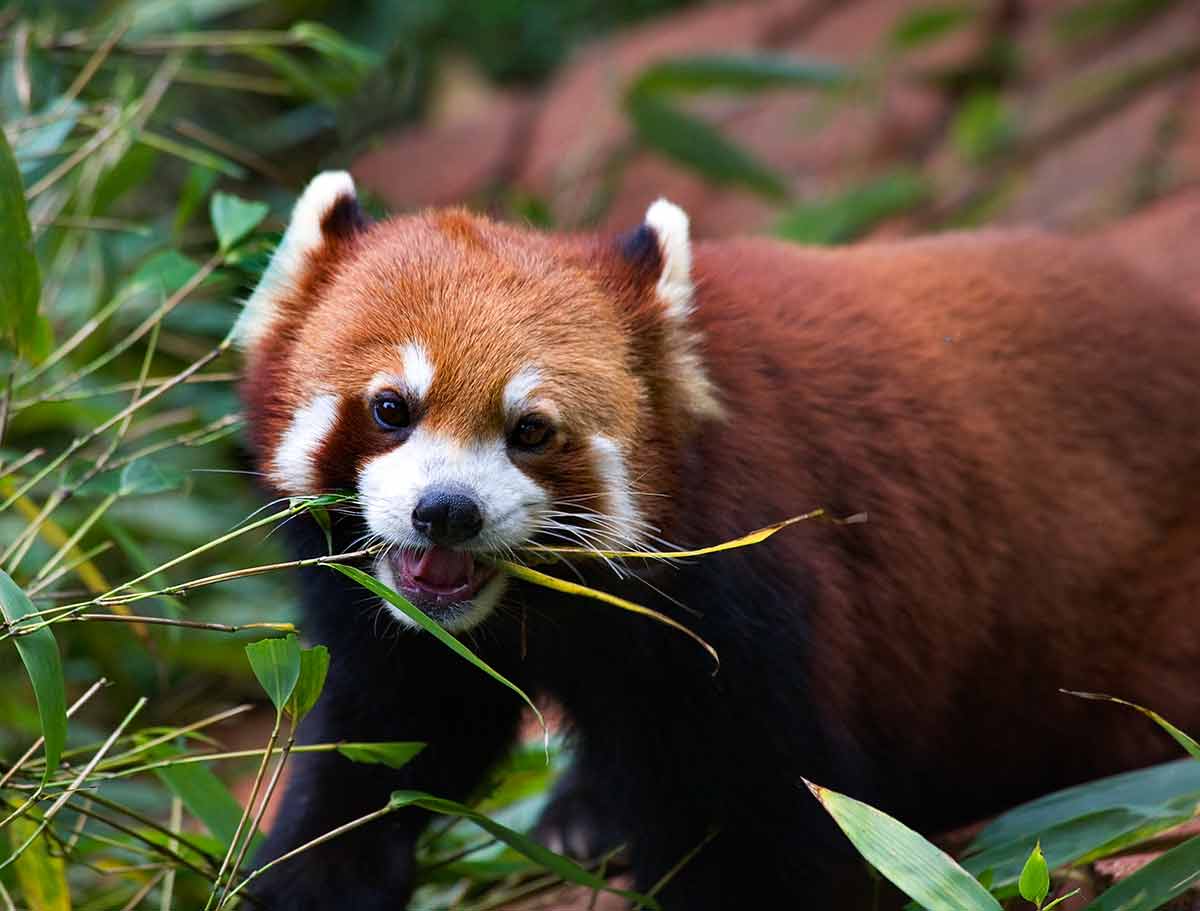
Although they share the same last name as the Giant Panda, the red panda doesn’t really look like a bear.
It’s a little bit bigger than a domestic cat but with a long tail.
Scientists believe the red panda is more closely related to raccoons, skunks and weasels.
Red pandas spend around 90% of their time in the trees.
They inhabit deciduous and coniferous forests and feed on bamboo just like giant pandas.
They primarily live in Nepal, Myanmar and central China.
Red pandas used to be found in Guizhou, Qinghai, Gansu and Shanxi but they became extinct due to habitat loss and poaching.
Now, red pandas can only be found in Yunnan, Sichuan and Tibet.
For the best chance of seeing red pandas in a semi-natural habitat head to the Chengdu Research Base of Giant Panda Breeding.
Alongside the 120 pandas there are also 76 red pandas.
3- Chinese Alligator
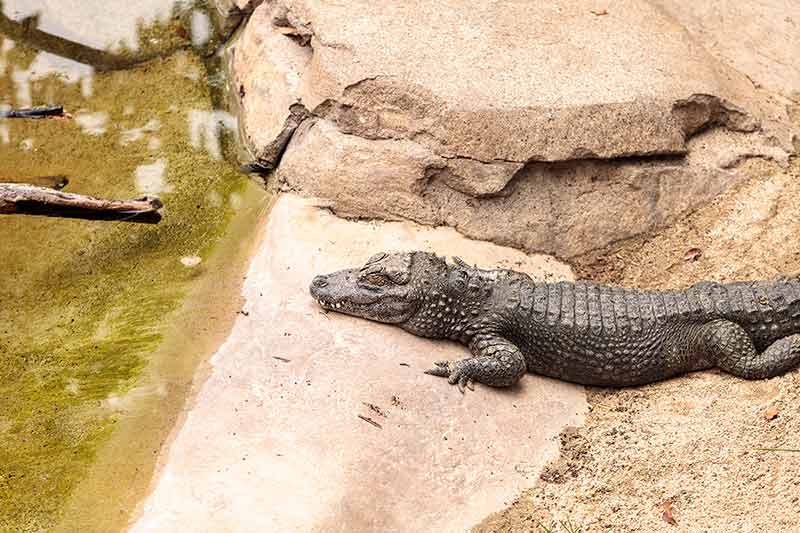
You don’t want to come across a Chinese alligator in the wild!
The Chinese alligators’ native habitat is the lower Yangtze in Anhui and Zhejiang provinces in eastern China.
This alligator is one of the few alligators outside of the United States, Central America and South America.
According to Chinese authorities the Chinese alligator population is beginning to recover.
From around 1996 the species was classified as “critically endangered” and in 2003, the population was less than 100.
Because of this the Chinese alligator was placed on a special species protection list by the Chinese government.
The Alligator Sinensis Nature Reserve in Anhui is making strides to increase the Chinese alligator population.
Using artificial breeding, the population has expanded to around 15,000 with 1,040 being released into the wild.
4- Golden Snub-Nosed Monkey
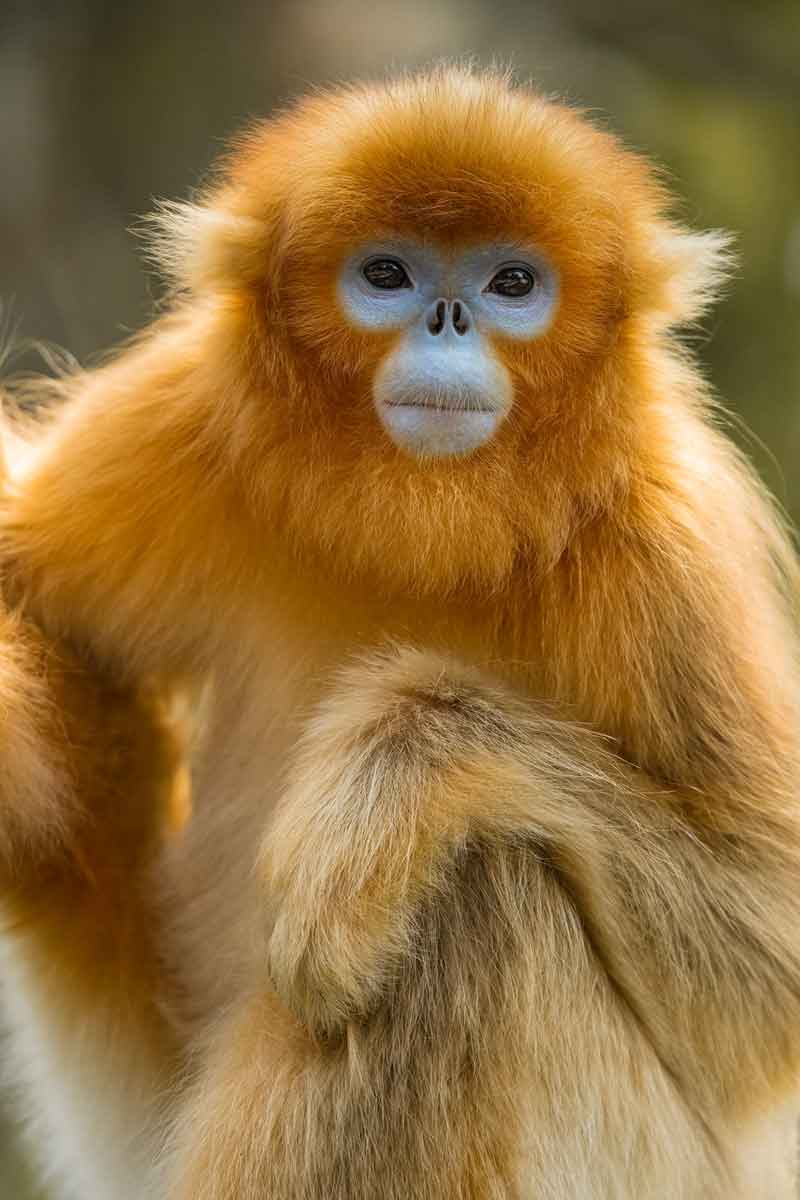
There are three types of snub-nosed monkeys, including one with gold fur and a blue face.
In China, the golden snub-nosed monkey is more commonly known by its Chinese name Sichuan golden hair monkey (四川金丝猴).
There’s also the black and white snub-nosed monkey otherwise known as the Yunnan golden hair monkey.
Finally, there is the grey snub-nosed monkey that lives in the high mountain forests in central China.
The forests in this area stand at 13,000 feet (3,962 m) above sea level, making it the largest high-altitude forest in the world.
There are an estimated 15,000 snubbed nosed monkeys with their numbers having fallen by around 50% over the past 40 years because of deforestation.
The monkey is still threatened by habitat loss and hunting (for medicine, meat, and fur) however they benefit from China’s Wildlife Protection Act of 1989 as well as the protection that giant pandas receive.
5- South China Tiger
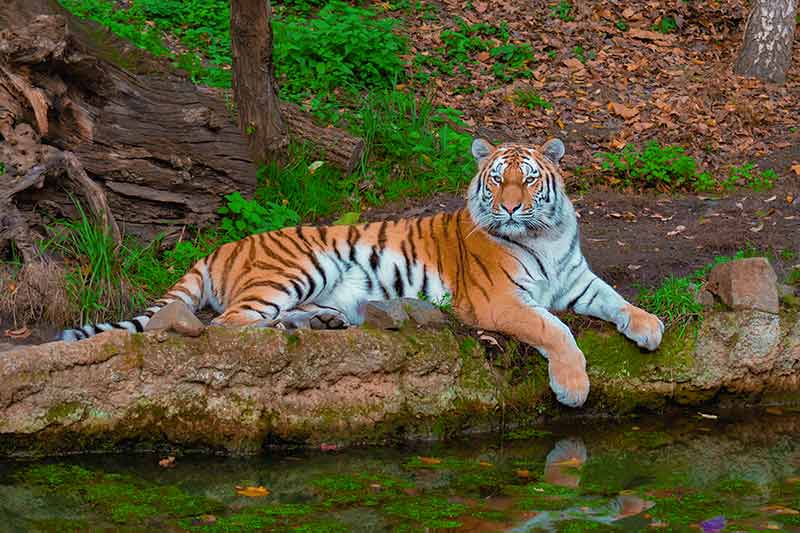
The South China tiger is also known as the Amoy, Chinese or Xiamen Tiger.
The tiger used to inhabit Fujian, Guangdong, Hunan and Jiangxi provinces.
Unfortunately, the South China tiger has not been seen in the wild for 25 years, so they are described as “functionally extinct”.
These tigers used to be found in the temperate forests of southeast China.
Many people believe that this was the original tiger and that all other tigers evolved from the Chinese tiger.
The tiger weighs around 100 to 195 kg (221 lb- 430 lbs).
In 2019 in Wangcheng Park Zoo in Luoyang City, Henan Province six new tiger cubs were born.
Some other places where you can see the South China tiger include Suzhou South China Tiger Breeding Base, Meihua Mountain South China Tiger Breeding Base, and Guangzhou and Shanghai Zoos.
For more things to do in China read:
- 25 Famous Landmarks in China
- Best Time To Visit China
- 20 Ways To Celebrate Christmas In China
- 20 China Beaches For Your Bucket List
- 20 Things To Do In Shanghai At Night
- 20 Things To Do In Guangzhou
- 21 Places To Visit In China
- 7 Things To Do In Xiamen
- 20 Things To Do In Xian
- Yangtze River Cruise
- Inner Mongolia In Winter
- Places To Visit In Yunnan
- 20 Things To Do In Beijing At Night
- 20 Smart Cities in China
- Winter in China – 20 Things To Do
- 15 Things China Is Famous For
- Living in China – Everything You Need To Know
- 20 Endemic Animals In China And Where To See Them
- 12 National Parks in China
- 20 Things To Do In Chengdu At Night
- 20 Things To Do In Chongqing At Night
6- Chinese Mountain Cat
The Chinese mountain cat is like the European wild cat, except for the colour of its fur.
This cat is mainly found in western China in the northeastern parts of the Tibetan plateau in Qinghai and northern Sichuan.
These cats are active at night and hunt for rodents, birds and pika (a small mountain mammal).
The Chinese mountain cat receives protection in China, but it is still classified as endangered.
That’s because pikas are the target of organised poisoning which in turn means it’s harder for the cats to find food and sometimes the poison can even kill the cats.
7- Crested Ibis
The crested ibis is a white-feathered bird with a red crest and a long black and red beak.
The crested ibis is endemic to China as well as a few destinations in East Asia, including Japan.
The crested ibis used to be widely seen across East Asia but due to pollution and other human activities the bird has now become rarer.
China has made strides to improve the population of the crested ibis.
Back in 1978 the crested ibis was believed to be extinct, with none having been sighted.
However, ornithologist Liu Yinzeng and his team travelled around 50,000 km to discover 260 former habitats of the birds.
It wasn’t until 1981 that a pair of adult crested ibises were discovered in Shaanxxi’s Yangxian County.
In 1990 the Crested Ibis Captive Breeding and Conservation Center was established in Yangxian with the hope of improve the population.
The population in Shaanxi alone is 6,654 with total figures exceeding 10,000!
8- Père David’s Deer
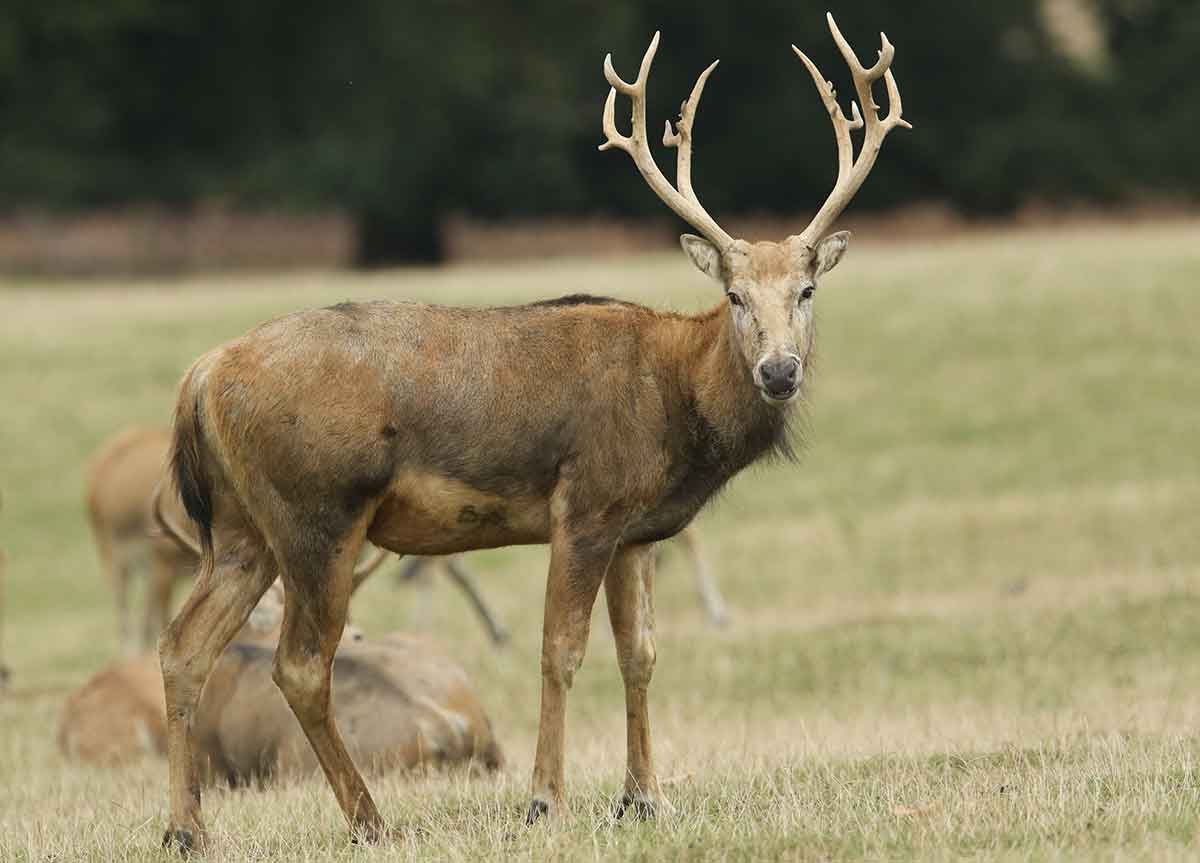
You would be right in thinking that the Père David’s Deer sounds more European than Chinese.
Well, that’s because it was named after a 19th century French missionary Père David who was responsible for making this Chinese animal known in Europe.
When hunting and flooding wiped out the population in China, Herbrand Russell, Duke of Bedford saved the species by acquiring the last of the world’s captive deer and breed them on his estate.
Today, the Père David’s deer is back in China and there are 6,000 in one of the reserves in China, with a total of 600 deer estimated to be living in the wild.
The National Nature Reserve Monitoring Center in Central China’s Hubei province is one of the places you can see deer in China.
Back in 2016 China’s Forestry Administration was able to release 16 deer into a large, unfenced park close to the Yangtze River.
They are being tentatively released back into the wild.
The deer weighs around 550 lb (249 kg) and is native to the Yangtze River basin.
9- Golden pheasant
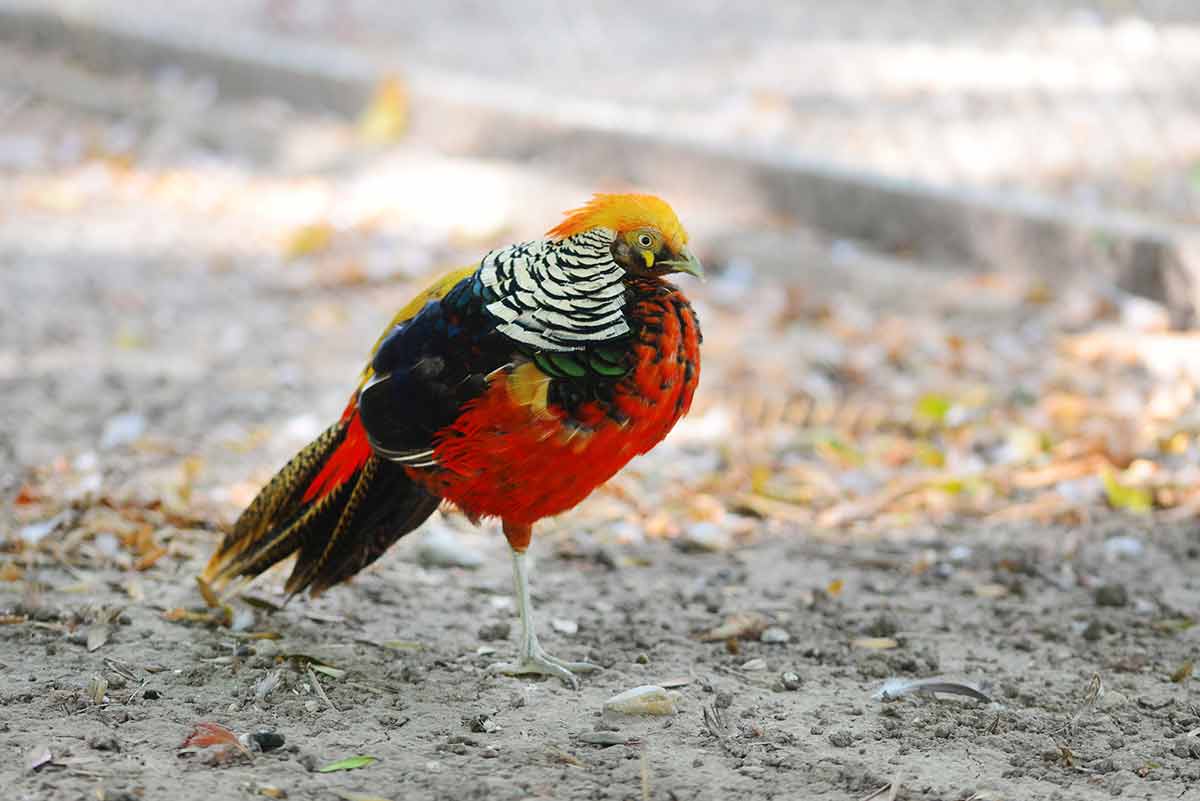
This fascinatingly colouring pheasant is also known as the Chinese pheasant or the aptly named rainbow pheasant.
The golden pheasant is primarily gold and orange but with a beautiful striped black and orange crest, splashes of blue and green and of course the iconic pheasant tail.
It really is a remarkable looking bird.
It is the male that looks this elegant and beautiful, the female looks rather more like the common pheasant (female) found in Europe.
The golden pheasant is thought by many to be the ancestor of the phoenix.
During the Qing Dynasty (1644-1911) bureaucrats’ robes were adorned with golden pheasant feathers.
This was a sign of grandeur and importance.
The golden pheasant inhabits the mountain forests of western China.
Though golden pheasant numbers appear to be decreasing, the threshold for the species to be labelled as “vulnerable” has not yet been reached.
10- Qinling Panda
You’ve heard of the giant panda and the red panda, but have you ever heard of the Qinling panda?
The Qinling panda is a subspecies of the giant panda.
It was first discovered in the 1960s, but it wasn’t recognised as a subspecies until 2005.
The big difference between the two pandas is that the Qinling panda has a smaller skull and dark brown and light brown fur as opposed to black and white.
There are an estimated 200 to 300 Qinling pandas in the wild and they are only found in the Qinling Mountains in southern Shaanxi Province.
They live at altitudes of 4,000 to 10,000 feet (1,300 to 3,300 metres) and their habitat and diet is the same as the giant panda.
11- Hainan Black-crested Gibbon
Hainan is an island in southern China, east of Vietnam.
Hainan is a popular vacation destination for Chinese people because of its picturesque beaches and warm year-round temperatures.
The Hainan black-crested gibbon is native to Hainan Island.
It was once believed that this gibbon was a subspecies of the Hoa Binh and Cao Bang gibbon from Vietnam but by studying molecular data it has been found that it’s a separate species.
The males are almost completely black (occasionally with white cheeks).
The females are golden in colour, with black patches and a dash of black on their heads.
The Hainan black-crested gibbon is listed as critically endangered on the IUCN Red List.
They used to live across half of China, but the population has plummeted over recent times.
In the 1950s there were around 2,000 gibbons on Hainan Island but in 2003 there were only 13.
12- Golden Takin
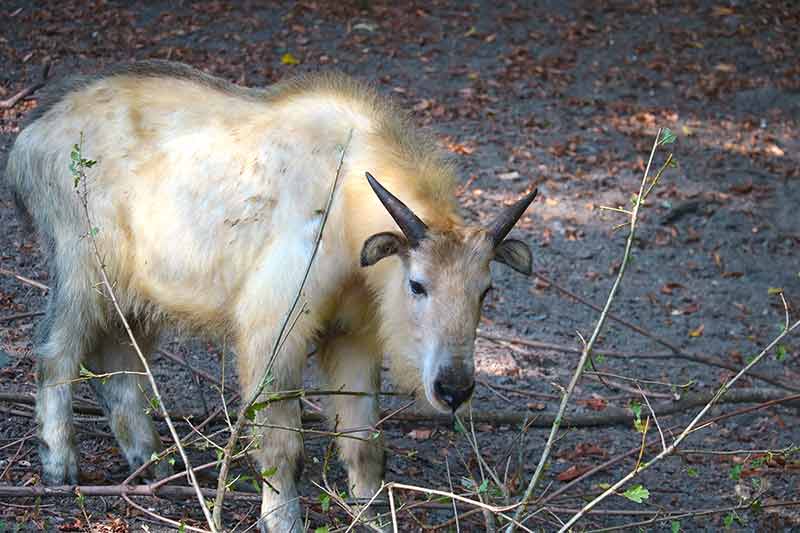
Another of China’s “golden” endemic animals is the golden takin, which has has a golden-yellow or creamy-white coat, with horns, hooves, and black nostrils.
The takin’s herd size varies depending on the season, but one herd can reach 300.
During the winter the herd breaks into smaller groups of around 10 to 35 takins.
Golden takins are a threatened subspecies of takin living in the forests of the Qinling Mountains in Shaanxi Province.
The main threat to golden takins is overhunting and habitat destruction.
According to the IUCN Red List the population of takin is around 5,069 and it’s classified as vulnerable.
13- Tufted Deer
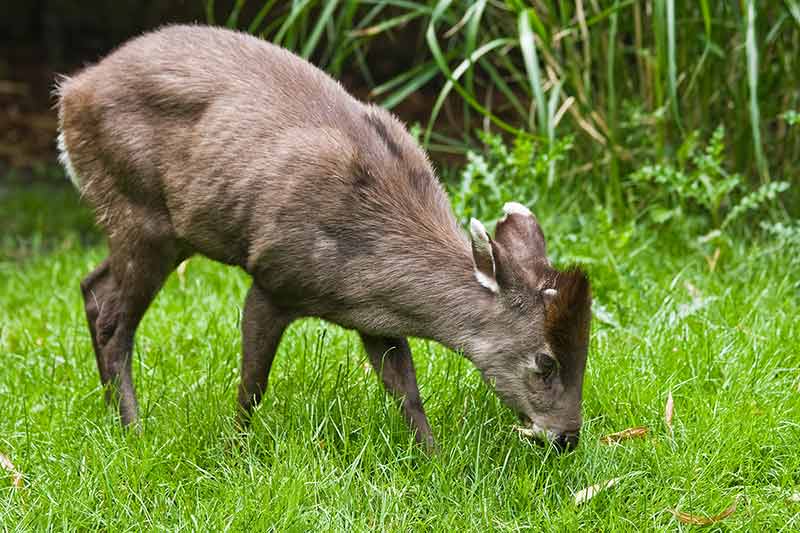
The tufted deer is named after the tuft of hair that sits like a mohawk between its ears.
They are light brown/grey in colour with darker legs.
The males have small antlers and long teeth.
The deer can grow to around 37 to 110 pounds (16 – 49 kg).
Males tend to live around 13 years with females living for around 11 years.
The tufted deer lives in southern and central China.
They live in forested areas at high altitudes around 300 to 4,600 meters above sea level.
They live from the southeast to eastern Tibet and to northern Myanmar.
As they live in the forest they tend to feed on grass, bamboo, fruit, and herbs.
Owing to overhunting and habitat loss the tuft deer is considered “near-threatened”.
There are believed to be around 300,000 to 500,000 deer left in the wild.
14- Asiatic Black Bear
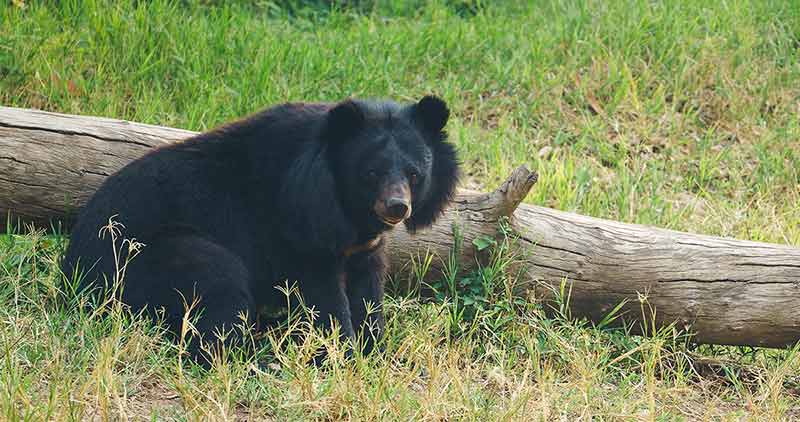
The Asiatic black bear can be found in Korea, Japan and China.
The black bear lives in the northeastern and southern parts of China.
The total number of Asiatic black bears is unknown but there are estimated to be around 28,000 in China.
The main areas where black bears live in China include Chang Bai, Zhang Guangcai, Lao Ye and the Lesser Xingan Mountains.
Asiatic black bears have been sighted in Qinjiangyuan National Forest Park which is around 460 km (285 miles) from Shanghai.
The Asiatic black bear is omnivorous, but they do occasionally attack domestic animals.
They have a glossy black (sometimes brown) coat with a white crescent on the chest.
They are very similar to their North American cousins but have a small body and a ruff of hair on the side of their face.
15- Chinese Giant Salamander
A traditional salamander is around 4 to 6 inches (10- 15 cm), but the Chinese giant salamander is a whopping 6 feet (1.8 metres)!
They are the largest amphibians in the world! They can weigh up to 100 pounds (45 kg) with the record holder weighing in at 110 pounds (49 kg).
The Chinese giant salamander spends all their time in the rivers near the Yangtze River basin in central China and usually gravitate to the rocky areas where water flows.
The Chinese giant salamander is listed as critically endangered.
There are approximately 50,000 in the wild with a farmed population of around 2,000,000.
They used to be found across central, southwestern, and southern China but now are mostly found from Qinghai east to Jiangsu, from Jiangsu to Sichuan, Guangxi, and Guangdong as well as the Yangtze, Yellow and the Pearl rivers.
16- Asian Elephant
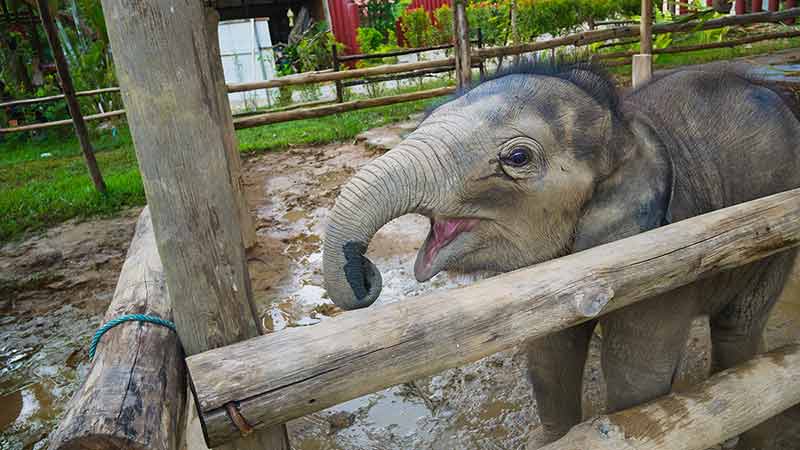
There are three types of elephants: the African Savanna (bush) elephant, the African forest elephant and the Asian elephant.
So, what are the differences between the African and Asian elephants? Well, the ears are the biggest difference between the two elephants.
Asian elephant’s ears are smaller, and the African elephant has more fan-shaped ears.
Also, only some male Asian elephants have tusks while both male and female African elephants grow tusks.
Asian elephants can be found mostly in Yunnan Province in southwest China.
You may remember in 2020 a herd of Asian elephants were reported to be trekking through China, wandering around 500 km (310 miles).
It is believed they started their journey in spring 2020 from Xishuangbanna National Nature Reserve to near the border with Myanmar and Laos.
For now, even scientists are unsure as to why they began on this journey, but it is likely to be in search of resources because of human interference and disturbances.
It is possible though that the movement was something to do with the social dynamic of the group.
Asian elephants in China are classified as “Class 1 State Protected”, which is the highest classification in China.
There are believed to be around 300 left in the wild, this significantly fewer than the beloved giant panda.
The IUCN lists the Asian elephant as “endangered”.
17- Clouded leopard
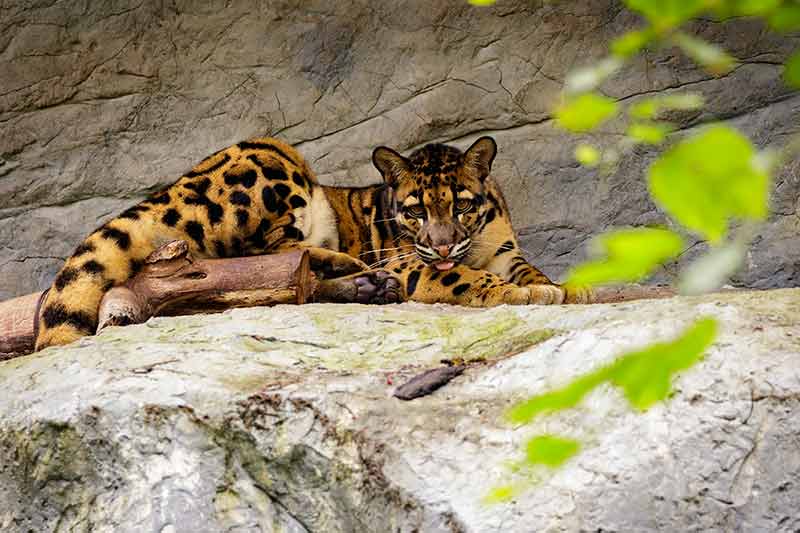
The clouded leopard is endemic to Southeast Asia and the Himalayas including southern China.
In China the clouded leopard is called mint leopard because of the markings resembling mint leaves.
Everyone’s heard of a leopard but the clouded leopard might have evaded you.
It was recorded as a species in 1821 but few people have seen one since.
The cloud-like spots are what gives the cat its name and they are most closely related to the snow leopard (found in 12 countries across Asia).
Today they are classified as being in the same taxonomic subfamily as tigers, lions, jaguars and the true leopard.
Male clouded leopards are twice the size of females.
They are usually found in rainforests but also in the dryer landscape of Southeast Asia.
In China they can be found in the southern subtropical forests, where they most spend their time up in the trees.
The total population of clouded leopards is believed to be around 10,000.
In many locations the clouded leopard was hunted for its fur.
To make a fur coat by their pelt would need around 25 leopards so you can see why their numbers dwindled so dramatically.
18- Sable
One of the smallest animals on this list of endemic animals to China is the sable.
The sable is a small mammal that is brown in colour with tints of orange on its upper body and a light brown coloured head.
Sables live in the dense forest areas of Russia, Mongolia and China.
In China they are found in northeast China, including the Greater Khingan Mountains, the Lesser Khingan Mountains, and the Changbai Mountains.
Perhaps owing to their size, the IUCN Red List lists the sable population as unknown.
However, estimates are in the range of around 18,000 in China, 2 to 2.2 million in Russia and 10,000 in Mongolia.
19- North Chinese Leopard
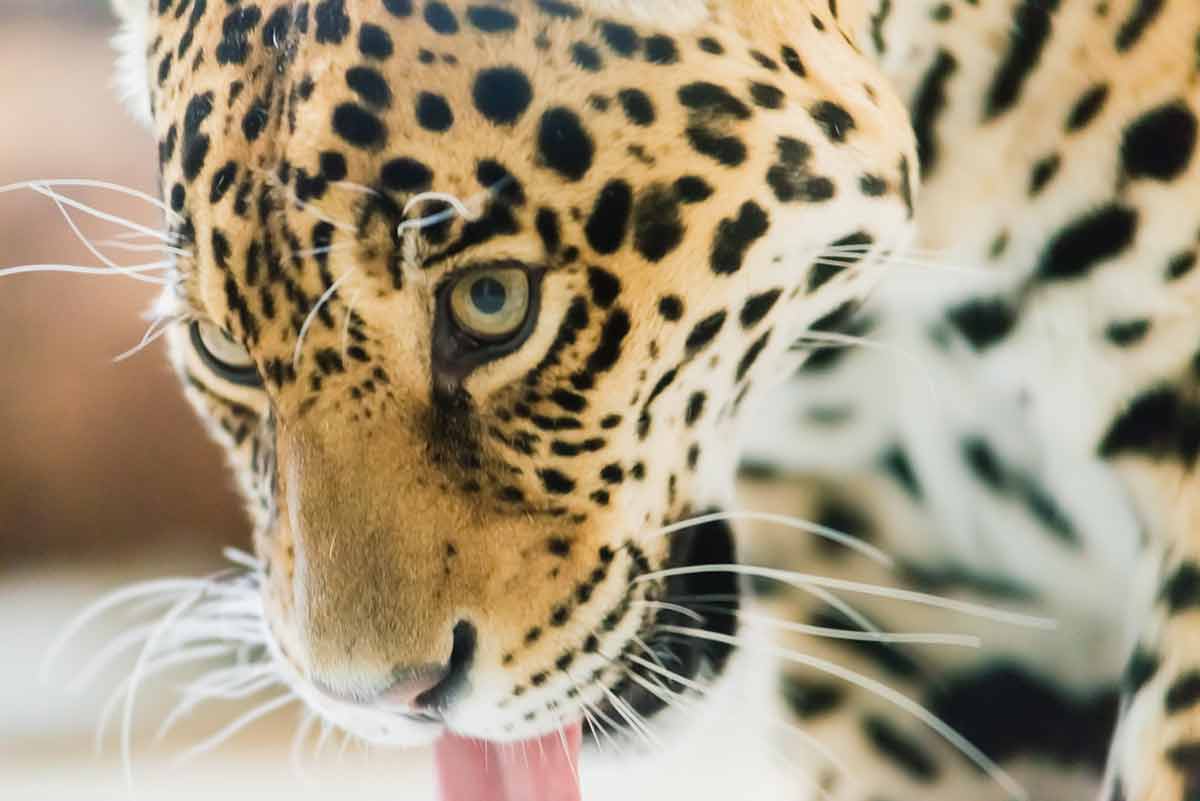
From the clouded leopard to the North Chinese leopard.
This leopard is also referred to as the golden coin leopard because of the black and golden spots.
The North Chinese leopard is one of the five “big cats” from the genus Panthera.
This leopard has short legs with a disproportionately large body and head.
Around 2,500 North Chinese leopards remain in the wild and only about 100 in captivity.
In April 2023 three wild North Chinese leopards were spotted in the northern part of Shanxi Province.
This leopard is classified as “endangered” according to the IUCN but is closely approaching “critically endangered” status.
The North Chinese leopard is a national first-grade protected animal in China.
20- Tibetan Macaque
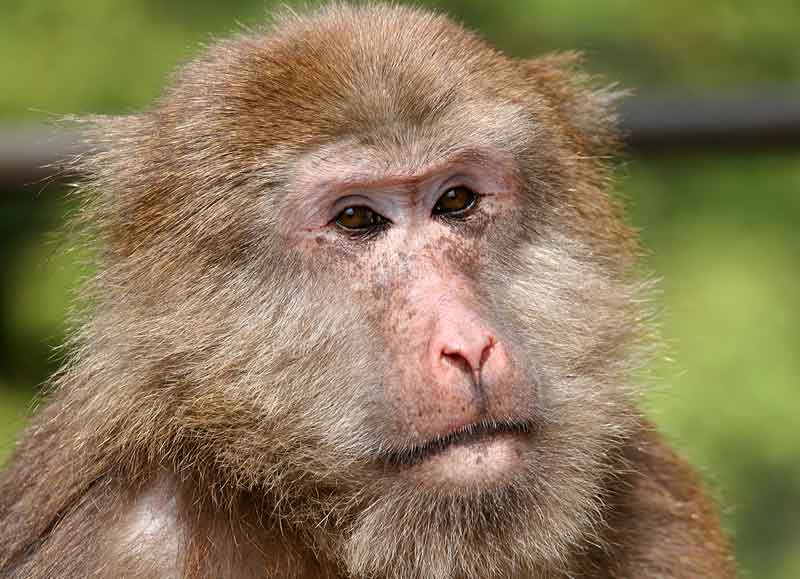
The Tibetan macaque is the largest of the macaques and one of the biggest monkeys in Asia.
The males usually weigh between 29 and 43 pounds (13 – 19 kg) while the females weigh around 20 to 29 pounds (9 – 13 kg).
Their thick fur coat can be sandy in colour or even dark broken.
It must be thick to keep the macaque warm in the cold Tibetan winters.
The Tibetan macaque or the Chinese stump-tailed macaque as it is sometimes known, is found in eastern Tibet right across to Guangdong and north to Shaanxi.
Sightings have also been made in northern India.
- Galapagos Islands Animals
- Tasmanian Animals
- 20 Canadian Animals
- 20 Asian Animals
- 21 Weird Animals Around The World
- 20 Animals in Canada
- 20 Animals in China
Plan Your Trip

Rent A Car – Find the best car rental rates at Discover Cars. They compare car hire companies to provide you with the best deal right now.

Find A Hotel – If you’re curious about this article and are looking for somewhere to stay, take a look at these amazing hotels.